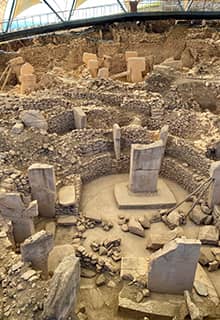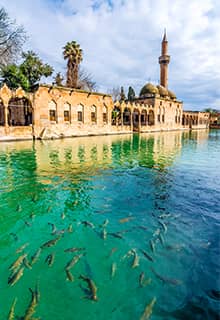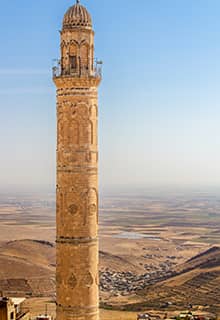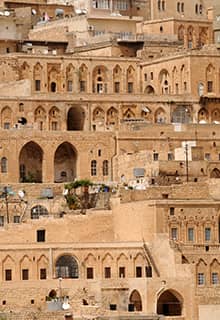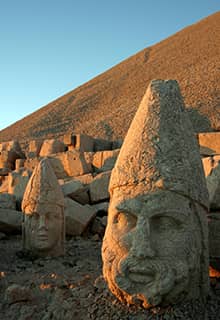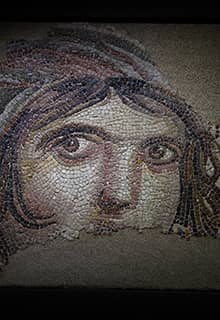

see
South Eastern Türkiye
Göbekli Tepe, the Zero Point in Time, in Şanlıurfa
Göbekli Tepe is a place of extraordinary scientific and cultural significance. Why? Because, apparently, it is the oldest temple built by humankind. Although it was referenced in 1963, it was only in 1994 that its real importance was revealed when the German archaeologist Klaus Schmidt began studying the site.
The huge stones laid out there, the earliest megaliths known to date, are about 11,000 years old, 6,000 years older than Stonehenge. The people who put them on that hill didn’t have any metal tools, nor had they even discovered pottery. Schmidt’s discoveries and subsequent study overshadow what was once the landmark that marked the beginning of human religion.
Göbekli Tepe, or “Potbelly Hill,” is about 10 km from Şanlıurfa. It was added to the UNESCO World Heritage List in 2018.
Halfeti in Şanlıurfa
Halfeti, founded in 855 BCE by King Assyrian Shalmanaser II, is located 102 km east of Gaziantep and was one of the villages affected by the Birecik dam and its reservoir. Unlike others, it was not submerged by the waters of the Euphrates, but part of the village did not escape submersion.
You can see the mosque on the edge of the new lake. If you look at the surface of the water, you will see the outlines of the houses that were submerged, an almost surreal sight.
Although these changes have transformed the area into a tourist attraction, there aren’t many accommodation options in Halfeti, mostly because the village is part of the “Cittaslow” movement that advocates a relaxed and leisurely urban culture.
Next to Halfeti there is a fortress – Rumkale – originally built by the Assyrians, and an abandoned, also semi-submerged village, Savaşan Köyü.
You can take a boat trip from Halfeti to Rumkale, where there is an interesting fortress on top of a hill, and up to Savaş.
To get to Halfeti from Gaziantep or Şanlıurfa, you’ll first have to take a shuttle to Birecik and then, from the market, another one to Halfeti.
Mount Nemrut in Adıyaman
Mount Nemrut has been a UNESCO World Heritage Site since 1987. It’s famous for the sculptures found at its summit, created by the Kingdom of Commagene, a political unit that was built on the fallen empire of Alexander the Great.
This kingdom lasted only for 200 years and was later incorporated into the Roman Empire. But for as long as it existed, it was well-known for its necropolis and tombs. It’s actually the final resting place of King Antiochus I and it’s his memorial that we find at the top of Nemrut Dağı.
The statues are between eight and nine metres tall, and there are representations of the monarch, lions, eagles, and various Greek, Armenian, and Median deities. Originally the statues were in a seated position, but at one point in time they were vandalized, their heads were removed and left scattered in the places where see them today.
There are also bas-reliefs and, of course, the mausoleum that some suppose must be the tomb of the king decorated in the same style of the sculptures. But not all archaeologists are convinced that we have yet found the king’s tomb.
Gülgöze Village, Güngören and Mor Gabriel Monastery in Mardin
Gülgöze is a mountain village just 11 km east of Midyat district. The settlement was established around the 10th century.
Nowadays Gülgöze is a very interesting place. Only 12 families live there, and there are some ruined stone houses. You will find three churches that can be visited.
Güngören is not far from Gülgöze, but unlike that village, you cannot easily get here on foot. It is 25 km southeast of Midyat and to visit you’ll need a car.
It’s a small village, with less than 200 people, who are Syriac Christians, located on top of a hill and surrounded by forest. There is a church in the village, dating from 778, but its main attraction is the monastery of Mor Gabriel, two km away.
Mor Gabriel, also known as Deyrulumur, is the oldest Syriac monastery in the world. It was created in 397 by Mor Shmu’el and his disciple Mor Shem’un. In the 6th century, 1,000 monks lived there, who even received direct donations from the Byzantine emperors. The monastery is still active and can be visited, and it’s even possible, with permission, to stay overnight.
Zeugma in Gaziantep
Zeugma was founded in 300 BCE by Seleucus I Nicator, one of the generals of Alexander the Great. Its named after a bridge that connected the two banks of the Euphrates and Zeugma means “bridge” or “passage” in ancient Greek.
In 256 BCE Zeugma was conquered by the Romans, and the transition to the Kingdom of Byzantium was natural. In 256 the king Sassanid Shapur I destroyed the city, which for a long time did not recover from the damages suffered and indeed never returned to the level of prosperity that it had had previously.
The attacks of the Arabs led to the abandonment of the city. The site was later inhabited, but in a disconnected way from the old Zeugma.
Like several other places of historical importance located in the region, Zeugma was partially submerged due to the creation of a dam and its reservoir. It’s estimated that 25% of the area of the city is currently under the waters of the Euphrates.
The magnificent Mosaic Museum of Zeugma, in the city of Gaziantep, was created with elements removed from the site before it was underwater.
Anyway, there’s still much to explore and to be excavated by archaeologists who continue to work on Zeugma.
The Old Town in Diyarbakır
Diyarbakır is a city with about one million inhabitants and with a long history.
The old stands out for its impressive black walls, built with basalt stone, with four main gates, one for each cardinal point.
There is plenty to see in this town: the Archaeology Museum, housed in a former prison, the Diyarbakir Grand Mosque, built in the 11th century, the oldest in Türkiye, the Armenian church of St. George, originally from the sixteenth century and recently restored, are just a few examples.
If you have the opportunity, especially if you know someone locally, go to Dengbêj Evi, the house where the ancient art of storytelling is preserved and where even today the elders gather to drink tea, sing and tell stories.
The walled area of Diyarbakır has been listed as a World Heritage Site by UNESCO since 2015.
Hasankeyf in Batman
The most stellar period of Mesopotamia was under Artukid rule after 1101 AD when Hasankeyf became the capital, and one of the most important centres on the Silk Road. It was known as Hısn Keyfa (Rock Castle) at that time. The bridge which once spanned the Dicle (Tigris) River and connected the two parts of the city with the ruined palace inside the citadel evokes the ghosts of a vanished dynasty. The 15th century Zeynel Bey Mausoleum, attractively decorated with turquoise tiles, shows Persian influence.
Kırmızı Medrese (Red Madrasah) in Şırnak
Kırmızı Medrese was built on the wall ruins in the west of the city. Inside the madrasah, ther are family cemeteries belong to the ancient rulers of Cizre and the tomb of Molla Ahmedi Ciziri, a scientist, poet, and literary writer. The exact construction date of thebuilding is not clear due to lack of documents. Experts date the structure to the first quarter of the 14th century.
There is a courtyard in the inner part of the madrasah, and the classrooms, dining halls and teacher lodgings in the west and north parts. You will see a square-planned room in the southwest of the madrasah, which is decorated with beautiful motifs.
The madrasah was named Red Madrasah because it was built from red bricks native to Cizre.
The Tumulus in Siirt
The Tumulus of Güzir, Tumulus of Türbe, Tumulus of Başur adorned with stunning bronze tomb gifts and Tumulus of Çattepe/Till (Tell Fafan), established in early Roman times as a prominent coastal town upon the crossroads of Botan and Tigris rivers, are among the most magnificent unearthed archeological sites of the city.
If you prick up your ears, you may hear whispers of history sprawling from Citadels of Kormas, Derzin and Şirvan (Küfe); historical Bridge of Nasreddin and Gerre Inn; majestic Ulu Mosque, the landmark of the city with minarets decorated with gorgeous tiles and countless shrines which reward the city with the title of, “City of Evliya” man of God.
Get lost in the maze of streets ornated with narrow gateways called “sabat”, wander through rock-hewn houses called “cas”, one of the superb examples of rock craftsmanship and do not forget to visit İsmail Fakirullah Tomb to see its “Light Refraction Mechanism” inscribed on UNESCO Tentative List of World Heritage in 2015 and İbrahim Hakkı Hazretleri Museum. You will be thrilled to see how cultures, religions, traditions, and customs exist without destroying one another.
Traditional Olive Oil Production Methods in Siirt
Olives, which mature at the end of fall, are collected, and brought to the factories to be ground in Kilis. However, to extract olive oil using traditional methods, the olives are brought to olive workshops called mahsara. These olives are ground by millstones continuing a millenia-old tradition. The only difference is that in the past people used to use horses, donkeys, or mules, while today, this duty is undertaken by engine power.
Beginning in mid-November, you can visit olive mills and see for yourself how the olive oil is extracted.

